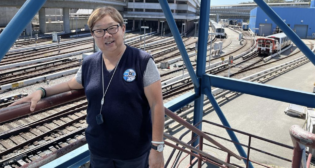
Shipper hypocrisy mocks regulatory history
Written by Frank N. Wilner, Capitol Hill Contributing EditorA recurring and intractable thread tying together railroad history is that when the choice has been between economic liberty and government intrusion, selecting the latter has repetitively discouraged capital investment, diminished service quality, adversely affected safety, and sooner than later caused hand-wringing among those most dependent on rail transportation.
Ignoring the lessons of history inspires, cultivates and enables aggressors who are never short of, nor shy with, self-serving justifications.
So it was March 25-26, when several shipper organizations, self-described as captive to, and abused by, railroads, implored the Surface Transportation Board (STB) to restore the old way of doing things. They asserted that circumstances, as defined by them, justify restoring government’s heavy hand in place of limited regulatory freedoms. They seek a regression to the regulatory regime of the late 19th century and most of the 20th century, when bureaucrats predominantly determined the level of railroad rates and service, and the timing of any changes.
History well records how things turned out. Hint: Not well at all, which was the reason for the Staggers Rail Act of 1980, which (another hint) was overwhelmingly supported by the same shipper groups whose memory now appears impaired. Absent the Staggers Act, the debate today would be led, also, by shipper groups, but rather focused on how to un-nationalize the rail industry and make it more flexible and responsive to market demands.
Attempting to rewrite history for the consumption of current STB members Dan Elliott and Ann Begeman—both of whom were in high school when the Staggers Act was debated and passed, and who now will determine the future (a third member of the agency awaits Senate confirmation)—are the National Industrial Transportation League (NITL), the American Chemistry Council and the Chlorine Institute. These shipper groups argued that the restoration of government’s heavy hand is a cure-all for their dismay over the level of railroad rates, railroad profits, and railroad stock-dividend payouts, which they perceive as too high.
In examining their arguments, it is instructive first to consider just who these return-to-the-past advocates are.
The NITL, contrary to implied declarations, does not speak for all of its dues-paying members, which include, yes, railroads, and many shippers quite supportive of reduced government intervention in railroad rate making. Indeed, shippers with first-hand or studied knowledge of history understand painfully the flight of investment capital and rail service deterioration in the pre-1980 Staggers Act era when regulators substituted their decisions for arms-length negotiations between those buying and selling rail transportation.
In fact, it was a previous NITL leadership team—one with notable pre-Staggers hands-on rail shipper experience—that expounded that price has meaning only in the context of service quality, and that higher freight rates are justified by increased capital investment and service improvements. That white paper seems to have conveniently disappeared from NITL files.
More telling is that the NITL objective—forcing railroads to open their privately owned and maintained networks to competitors for the sole purpose of driving down freight rates, and absent any demonstration of anticompetitive conduct—has not previously been sought by any NITL member. Of course, this is because shippers with real knowledge of railroad operations understand that the NITL proposal would recreate the very inefficiencies that past mergers and STB-attached conditions were intended to—and did—eliminate. Equally illuminating is that NITL members already have an effective rate grievance forum at the STB, and are in the winning column with a 78% success rate.
The NITL’s two fellow travelers are the American Chemistry Council and Chlorine Institute, whose members make products that go boom and are instruments of mass destruction when mislabeled or otherwise mishandled, and thus impose great liability risks on railroads. These hazmat shipper groups’ assault on railroad rates and profits defies explanation, as it is railroad profits that make possible safety enhancing renewal of plant and equipment, which includes the costly design, development and implementation of Positive Train Control, and improved handling of the dangerous cargoes their members tender railroads.
Here’s a reality check: Could the representative of Dow Chemical, who appeared before the STB in support of the NITL, be serious in reinforcing NITL complaints about railroad rates, profits and monopoly power? In its own communications with investors, Dow emphasizes a 71% boost in Dow’s stock price over the past year, a 31% improvement in earnings per share, and the value of its own monopoly — patents, which, unlike sole-served rail points, cannot be broken by manufacture elsewhere, its threat, or the use of trucks.
As for the American Chemistry Council, it boasts representing a $770 billion industry that generates 25% of gross domestic product, employs 800,000, and whose profits fuel $39 billion annually in capital investment — numbers that dwarf railroad industry financial statistics and belie any insinuation of excessive bargaining power in the hands of railroads when rates are negotiated bilaterally.
For sure, the battle advanced by those seeking to restore the footprint of government leviathan is a battle on behalf of their own members’ stockholders, as any artificially forced rollback of railroad rates will accrue not to consumers, but to corporate stockholders.
Annual reports of the STB, its predecessor Interstate Commerce Commission (ICC), dozens of readily available authoritative, footnoted and indexed text books, and scores of similarly scholarly journal articles tell well the wretched story of railroading under the heavy hand of government.
An early failure to understand high fixed-cost, network industries spawned 19th century ruinous competition; a mismanaged attempt at government-directed rail mergers accelerated bankruptcies during the Great Depression and slowed the market-generated merger process afterward; and sloth-like rate regulation after World War II prevented railroads from timely adjusting, both upward and downward, their prices and service levels to meet growing truck and barge competition.
By the 1970s, the straight-jacket of regulation into which railroads had been forced spawned a wave of bankruptcies approaching the level of the Great Depression. Regulatory freedoms, supplemented through mergers that produced network paring of redundant track, yards, and terminals, restored the then deeply troubled railroad industry to financial health. Yet at the core of the NITL’s objective is repatriation, through government fiat, of the time-consuming, excessively costly, and productivity-sapping interline and yard switching that once propelled railroads down a fast track toward nationalization.
No matter how the shipper arguments are chopped, cubed, diced, minced, sliced, shredded or otherwise presented, the substitution of government fiat for market-based solutions will adversely affect traffic flows, swell the number of time-consuming and costly interline and yard switches of freight cars, reduce network reliability, and cause an overall reduction in service quality. Any immediate price reduction will be transient, at best.
The shipper groups assert the NITL proposal will barely dent rail profitability, but if that is so, the question is begged as to why so much shipper money is being plowed into the effort. As for shipper assertions that such a scheme exists also in Canada, and has not dented Canadian railroad profitability, there are many differences between the more extensive and complex U.S. rail network and the Canadian rail, highway, and waterway systems. To proclaim, “Canada does it, so we should also,” invites the silliness of importing, without appropriate analysis, the Canadian national health system, its different form of national and provincial government, and the metric system.
What is being proposed by the NITL goes well beyond any action ever taken by the STB or its ICC predecessor in the 127-year existence of the regulatory agencies. In fact, there is no statutory language on which to base an affirmative ruling. This is not lost on Congress. The bipartisan leadership of the House Transportation & Infrastructure Committee recently issued a stern written warning to the STB about the chutzpah of treading on congressional turf. If pragmatic heads know better than to tug on Superman’s cape, spit into the wind, or pull the mask off that old Lone Ranger, they correspondingly comprehend why one doesn’t defile the front lawn of Congress.
Judge Thomas Cooley, the ICC’s first chairman, left for his inheritors some sage advice: “A fanatical or sensational course rarely leads to good results.”
Given the bitter economic lessons of previous government interference with market-based solutions, and the proven effective grievance machinery already available to shippers, the STB would be mocking Judge Cooley by embracing the radicalism advanced by the NITL, American Chemistry Council, and Chlorine Institute.



